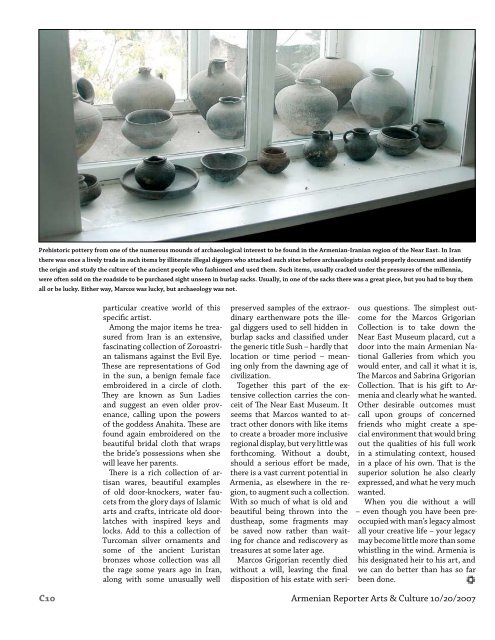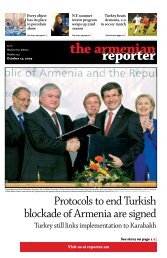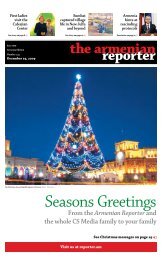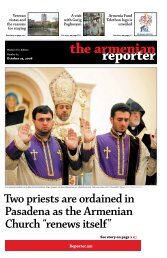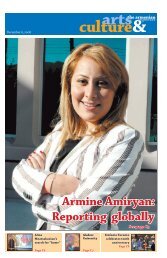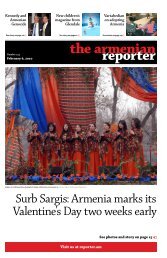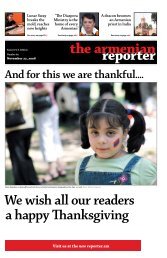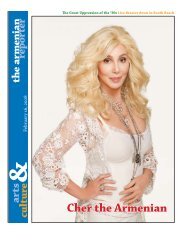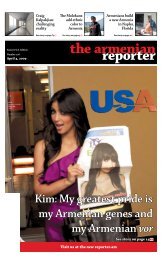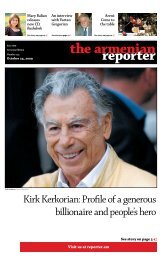Leading lady Karen Kondazian - Armenian Reporter
Leading lady Karen Kondazian - Armenian Reporter
Leading lady Karen Kondazian - Armenian Reporter
Create successful ePaper yourself
Turn your PDF publications into a flip-book with our unique Google optimized e-Paper software.
Prehistoric pottery from one of the numerous mounds of archaeological interest to be found in the <strong>Armenian</strong>-Iranian region of the Near East. In Iran<br />
there was once a lively trade in such items by illiterate illegal diggers who attacked such sites before archaeologists could properly document and identify<br />
the origin and study the culture of the ancient people who fashioned and used them. Such items, usually cracked under the pressures of the millennia,<br />
were often sold on the roadside to be purchased sight unseen in burlap sacks. Usually, in one of the sacks there was a great piece, but you had to buy them<br />
all or be lucky. Either way, Marcos was lucky, but archaeology was not.<br />
particular creative world of this<br />
specific artist.<br />
Among the major items he treasured<br />
from Iran is an extensive,<br />
fascinating collection of Zoroastrian<br />
talismans against the Evil Eye.<br />
These are representations of God<br />
in the sun, a benign female face<br />
embroidered in a circle of cloth.<br />
They are known as Sun Ladies<br />
and suggest an even older provenance,<br />
calling upon the powers<br />
of the goddess Anahita. These are<br />
found again embroidered on the<br />
beautiful bridal cloth that wraps<br />
the bride’s possessions when she<br />
will leave her parents.<br />
There is a rich collection of artisan<br />
wares, beautiful examples<br />
of old door-knockers, water faucets<br />
from the glory days of Islamic<br />
arts and crafts, intricate old doorlatches<br />
with inspired keys and<br />
locks. Add to this a collection of<br />
Turcoman silver ornaments and<br />
some of the ancient Luristan<br />
bronzes whose collection was all<br />
the rage some years ago in Iran,<br />
along with some unusually well<br />
preserved samples of the extraordinary<br />
earthenware pots the illegal<br />
diggers used to sell hidden in<br />
burlap sacks and classified under<br />
the generic title Sush – hardly that<br />
location or time period – meaning<br />
only from the dawning age of<br />
civilization.<br />
Together this part of the extensive<br />
collection carries the conceit<br />
of The Near East Museum. It<br />
seems that Marcos wanted to attract<br />
other donors with like items<br />
to create a broader more inclusive<br />
regional display, but very little was<br />
forthcoming. Without a doubt,<br />
should a serious effort be made,<br />
there is a vast current potential in<br />
Armenia, as elsewhere in the region,<br />
to augment such a collection.<br />
With so much of what is old and<br />
beautiful being thrown into the<br />
dustheap, some fragments may<br />
be saved now rather than waiting<br />
for chance and rediscovery as<br />
treasures at some later age.<br />
Marcos Grigorian recently died<br />
without a will, leaving the final<br />
disposition of his estate with serious<br />
questions. The simplest outcome<br />
for the Marcos Grigorian<br />
Collection is to take down the<br />
Near East Museum placard, cut a<br />
door into the main <strong>Armenian</strong> National<br />
Galleries from which you<br />
would enter, and call it what it is,<br />
The Marcos and Sabrina Grigorian<br />
Collection. That is his gift to Armenia<br />
and clearly what he wanted.<br />
Other desirable outcomes must<br />
call upon groups of concerned<br />
friends who might create a special<br />
environment that would bring<br />
out the qualities of his full work<br />
in a stimulating context, housed<br />
in a place of his own. That is the<br />
superior solution he also clearly<br />
expressed, and what he very much<br />
wanted.<br />
When you die without a will<br />
– even though you have been preoccupied<br />
with man’s legacy almost<br />
all your creative life – your legacy<br />
may become little more than some<br />
whistling in the wind. Armenia is<br />
his designated heir to his art, and<br />
we can do better than has so far<br />
been done.<br />
f<br />
C10 <strong>Armenian</strong> <strong>Reporter</strong> Arts & Culture 10/20/2007


